The New Year is about celebrating past accomplishments and setting goals for an even better year to come—and the TrophyCatch program is excited to do both! Looking back through the seasons, the TrophyCatch program has seen a staggering increase in the number of participating anglers and qualifying catches which has led to a prizing update for the remainder of our 5th Season. This citizen science partnership has led to more than 5,325 approved catches, which is instrumental in ensuring that FWC biologists are able to make informed decisions for the management and improvement of Florida’s lakes and rivers. Thank you for your continued participation and support of TrophyCatch! |
|
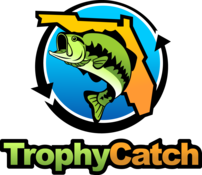 |
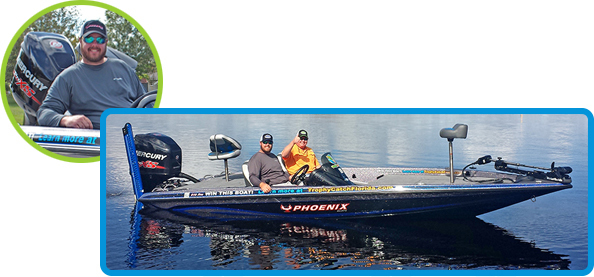 |
Congratulations to our TrophyCatch Season 4 Phoenix bass boat winner! Andrew Bowen from Ocala was the winner of the final drawing for the boat during Bartow Ford’s Winter Wonderland event in December. This Phoenix Boats 619 Pro is powered by a 200 Mercury Marine and MotorGuide trolling motor then anchored by Power-Pole®. Thanks goes to all our boat partners for providing such an awesome prize that helps to make the TrophyCatch conservation program not only fun but also rewarding! Note that we have already taken delivery of the Season 5 Phoenix 819 Pro for Season 5! If you’re already registered for TrophyCatch you’re automatically entered for the new random drawing, but if not register now to make sure your name’s included.
 Join us in congratulating our Season 4 Hall of Fame winners! The Hall of Fame Club includes only those qualifying Florida-caught bass 13 pounds or larger submitted to TrophyCatch, and there were 7 this past season. Each winner received a full size replica mount by New Wave Taxidermy, Bass Pro Shops gift cards and other prizing. Paul Desrosier was the Season 4 Champion with the largest bass of the season at 14 lbs 10 oz from Jessamine Lake in Pasco County. Each of these giant bass was released as a requirement of the TrophyCatch conservation program to allow other anglers to share the thrill of the trophy bass catch of a lifetime. Desrosier now proudly wears the TrophyCatch HOF Ring provided by American Outdoors Fund.
|
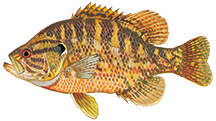 Size: The state record is 2.44 pounds. Most individuals will average close to a quarter pound. The Big Catch minimum qualifying sizes are 0.5 pounds or 9 inches for adults, and 0.4 pounds or 7 inches for youth (BigCatchFlorida.com).
Identification and similar species: Look for the unique, dark stripes on the cheek radiating back from the
red eye. Also note the proportionally large mouth when compared with
other sunfishes. The warmouth may occasionally have a tinge of red on the edge of the
operculum, suggesting a redear sunfish. However, the much larger redear
lacks the distinctive cheek markings.
Angling qualities: This diminutive species has similar habits when compared to the more
popular bluegill and redear sunfish, and is often caught on the same
lures and baits (live worms, crickets, grass shrimp, jigs, spinners and
beetle spins). The comparatively larger mouth allows the warmouth to
eat bigger prey items, so this fish goes after small minnows or tiny
crankbaits more commonly than other bream species. Although the
warmouth is usually caught incidentally while fishing for larger
species, it puts up a good fight on ultralight tackle and good-sized individuals will often find a place in the panfish angler’s creel.
Where to catch them: Warmouth are common throughout Florida. While there aren't any sites that are famous for their warmouth fishing, any shallow lake, swamp, marsh or slow-moving stream or canal is a likely spot. They stay around aquatic vegetation, stumps and snags and under the banks of streams and ponds. They have more tolerance for muddy water than most species.
Warmouth illustration by Duane Raver, Jr.
|
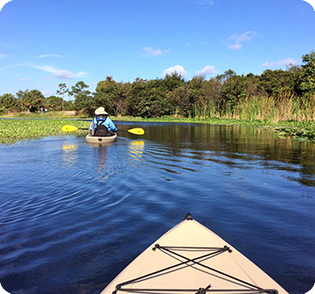 Size: 356 acres (Lake Osborne) and 159 acres (Lake Ida), plus 17 miles of interconnecting canals.
Location: Palm Beach County.
Description: Lakes Osborne and Ida provide some of the best available freshwater fishing in southeast Florida. Located in eastern Palm Beach County, they offer surprisingly good angling for a suburban setting. Fish species available include largemouth bass, sunshine bass,
peacock bass, black crappie, bluegill, redear sunfish, channel catfish and Mayan cichlids—all present in good numbers and good sizes.
Largemouth bass are most popular, and anglers on these lakes advise that finding hydrilla is the key to finding the fish. Although not on par with nearby Lake Okeechobee, bass exceeding 8 pounds are present in the Osborne-Ida chain. Recent mild winters have also allowed peacock bass to repopulate both lakes following the freeze of 2009-10, and they are plentiful enough that guides are targeting them on both sites. However, more southern Lake Ida is a slightly better bet for peacocks. Sunshine bass are stocked regularly by FWC in order to maintain a fishable population of this sterile hybrid. Sunshine bass fishing is usually best from October to
February, and during this period the 6th Avenue Bridge on Lake Osborne is a favorite ambush spot for targeting these fish. Native and exotic panfish including bluegill, redear sunfish and Mayan cichlid are found throughout both lakes and the interconnecting E-4 Canal system. Black crappie and channel catfish, while also present within the canal system, do best in the lakes and there are deeper holes in both Osborne and Ida that can provide good fishing for them.
There are 15 fish attractors dispersed throughout the Osborne-Ida chain of lakes. These artificial reefs are constructed of man-made materials. Geowebb netting and PVC pipe are fastened together to form panels that are placed on the bottom and stand upright in the water column. Artificial reefs are marked with PVC buoys.
Good shoreline access and fishing piers are available on both lakes, as well as public multi-lane boat ramps in excellent condition. Be aware that this easy access also makes the lakes very popular with water skiers, pleasure boaters and campers. However, the interconnecting canals can provide a bit of refuge (and good fishing) during busy weekends. Picnic pavilions, a campground and public restrooms are also present. An Osborne-Ida Chain of Lakes brochure and map is available, as well as a Central E-4 Canal Angler Guide that maps the interconnecting canals.
|
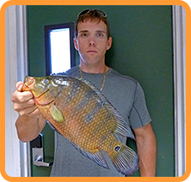 FWC fisheries biologists certified the first State Record Mayan cichlid weighing 2.37 pounds caught by Jonathan Johnson from Fort Myers on Nov. 28, 2016. Johnson caught the fish in a Collier County canal on a lipless crankbait, and relates that his record catch was not by accident.
“I looked up the record about six months ago and saw that it was vacant,” said Johnson. “I have caught hundreds [of Mayan cichlids] but only a couple that I thought were large enough. I was targeting them specifically that day and caught about 25—this being the largest one by about half a pound,” he said.
Johnson took the fish home where his scale confirmed that it was eligible for the vacant state record, which had a minimum submission weight of 2 pounds. Johnson then called the FWC offices to get his record fish certified.
|
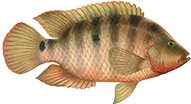 The FWC made the Mayan
cichlid, a nonnative species from Central America, eligible for state
record status in 2012. But, the record has remained vacant until now.
The Mayan cichlid was first reported in Florida in the early 1980s.
During the mid-1990s, the fish began expanding its range and has become
common throughout south Florida’s freshwater lakes and canals.
There
are 34 nonnative freshwater fish species that have become established
in Florida. Although these species have not caused major disruptions in
native ecosystems or reduced harvest of native sport fishes, the FWC
strongly encourages anglers not to release them (except
legally-introduced peacock bass and triploid grass carp). In addition,
releasing fish from aquariums or moving them between water systems is
illegal and could produce detrimental effects.
Mayan cichlid illustration by Diane Peebles.
|
Abraham Lincoln once said, “It is better to keep one’s mouth shut and be thought a fool than to open it and resolve all doubt.” You can tell a lot about a person by what comes out of their mouth—but did you know you can tell a lot about a fish by looking at the shape of its mouth?
The shape of a fish's mouth is mostly determined by what it eats. The largemouth bass (aka “bigmouth bass” or "bucketmouth") didn’t get its name for nothing. This ambush predator eats just about anything: other fish, snakes, frogs, crayfish, insects, turtles and even birds! In order to
effectively capture a wide variety of fast-moving prey, this fish’s
“bucketmouth” is a great help. A bass will literally inhale its prey
into its cavernous mouth, then expel the excess water. Its gill rakers
allow water to pass through, but make sure that dinner stays put. The
bass is definitely one fish whose dental gear tells a lot about its
lifestyle! |
|
 |
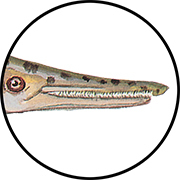 |
|
Gar and pickerel feed almost exclusively on fish. Their long, thin mouths present a streamlined frontal surface so that they can move
forward quickly and efficiently to run down their agile prey. Once they
bite, they have mouths loaded with teeth to keep hold of a wriggling
fish. If bass are buckets, these fish are spears. If you’d never seen a
gar before, you’d still be able to guess pretty easily that its mouth is
designed to hang onto something that’s usually pretty good at
getting away. |
Sunfish have tiny, dainty mouths that are a pretty good match to the
tiny critters they eat. Although they also eat a variety of prey like
bass do (insects, crustaceans, worms, fish), the difference is that they
don’t eat nearly as wide a variety of foods, and most of their prey is
much smaller. A bluegill, for example, has an ideal body shape for
making short dashes to nab grass shrimp or dragonfly larvae out of dense
vegetation, and it doesn’t need a bigger mouth for grabbing such tiny
morsels. A redear sunfish’s mouth is similarly matched for such meals.
The redear’s mouth also accommodates its habit of picking small clams
and snails off the bottom, and in an even more advanced adaptation
actually has hard crushing plates in the back of its mouth for breaking
them open. |
|
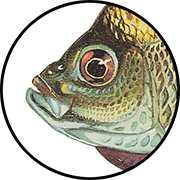 |
 |
|
Catfish probably exhibit the greatest mouth specialization, not because
they eat a narrow range of foods (they don’t), but because of how
highly adapted they are for finding it. Catfish are scavengers that have
taste- and touch-sensitive barbels around their mouths that help them
to smell and locate any food in the immediate area. Commercial “stink
baits” capitalize on this by having strong-smelling ingredients that attract catfish. Going one step further, sensory cells on catfish
barbells practically allow them to taste their food outside of their
mouths before they swallow it. The underside of a catfish’s mouth is
flat, also allowing it to more easily feed along the bottom. |
So the next time you see a fish, remember Abraham Lincoln’s advice. And
take a close look at the fish’s mouth—you might learn something
important!
Fish illustrations modified from Duane Raver, Jr.
To contact the Florida Freshwater Angler, email John Cimbaro.
|